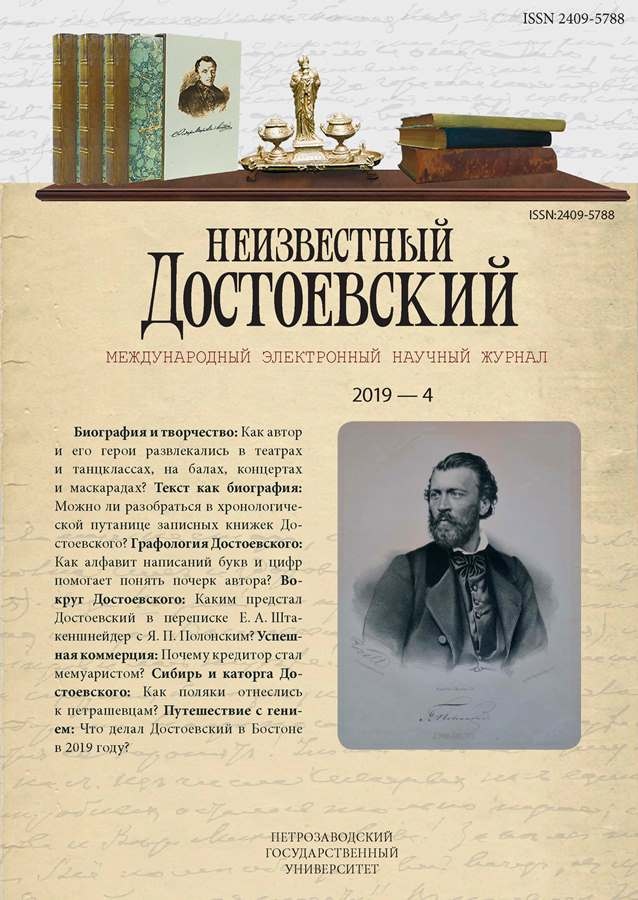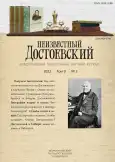Том 9, № 3 (2022)
Статьи
Задачи атрибуции анонимных статей в изданиях Достоевского
Аннотация
В журналах «Время», «Эпоха» и в еженедельнике «Гражданин» опубликован большой объем анонимных статей, которые могли бы быть написаны Достоевским. Их значение велико: в фельетонах, критике и полемических статьях писатель развивал новое идейное направление — «почвенничество». За последние пятьдесят лет значительно расширен корпус текстов, которые уверенно приписываются Достоевскому. В их атрибуции накоплен существенный опыт проб и ошибок, который дает возможность поставить и решить ряд методологических проблем. Почти бесспорный критерий определения принадлежности публикации — литературная подпись автора, однако в журналистской практике подписанный текст не всегда сочинен лицом, его подписавшим, — иногда авторство принадлежит редактору или сотруднику редакции. Сам Достоевский публиковал некоторые из написанных им статей от имени М. М. Достоевского, «семейства М. М. Достоевского», А. У. Порецкого, В. П. Мещерского. Анонимность была условием публикации многих статей. Редакция покупала текст, приспосабливала его к направлению журнала, исправляя начало и конец, делая вставки и примечания, нередко редактор переписывал чужой текст, иногда обрабатывал компиляции. В настоящее время начался новый этап обсуждения проблем атрибуции. В научный оборот введены не публиковавшиеся прежде источники — в частности рукописные приходо-расходная и гонорарная книги 1860—1865-х гг., которые вел сначала М. М. Достоевский, а потом — Ф. М. Достоевский. Их изучение расширяет аргументацию исследователей. Важное значение в определении авторства имеет применение математических методов. Большинство существующих математических методик атрибуции несостоятельны, прежде всего они не убеждают самих математиков. Есть апробированные методики. Их использование позволяет доказательно обосновать авторство и соавторство Достоевского в написании анонимных и псевдонимных статей, выявить редактирование им чужих текстов. Необходимо дальнейшее совершенствование статистических методов в определении авторства.
 5-24
5-24


Проблемы атрибуции в «Гражданине» Достоевского: дебаты и аргументы
Аннотация
После смерти Достоевского возникла необходимость создания единого корпуса текстов для издания Полного собрания сочинений. При его подготовке особую сложность вызвали опубликованные писателем анонимные и псевдонимные материалы. Вдова Достоевского, Анна Григорьевна, собрала совещание для обсуждения вопроса о включении таких статей в корпус текстов писателя. В итоге было принято решение исключить материалы, не подписанные Достоевским. Это был первый опыт составления посмертного собрания сочинений писателя. Вопрос об анонимных и псевдонимных статьях в изданиях, редактируемых Достоевским, оставался открытым и требовал дальнейшего изучения. Впервые анонимные тексты вошли в собрание сочинений Достоевского, подготовленное под редакцией Л. П. Гроссмана. Он настаивал на важности всех материалов, над которыми работал писатель. В дальнейшем у издателей была задача определить полный корпус текстов Достоевского. Более ста лет ведется большая работа по установлению авторов материалов, опубликованных в «Гражданине»: продолжаются активные дискуссии и обсуждения атрибуций, выдвигаются новые гипотезы авторства текстов, раскрываются неизвестные авторы издания, публиковавшиеся под псевдонимами, дополняются сведения о сотрудниках «Гражданина» и корреспондентах писателя, изучаются особенности редакторской работы Достоевского. Важным этапом исследований стали подготовленные И. Зохраб и В. А. Викторовичем хронологические росписи номеров «Гражданина» за 1873–1874 гг. с указанием авторов анонимных и псевдонимных статей. В данной статье представлен обзор исследований по атрибуции материалов «Гражданина». Однако в изучении этой проблемы до сих пор не поставлена точка. Необходимо искать новые пути ее решения, поскольку они способствуют оценке вклада Достоевского в концепцию и редакционную политику издания.
 25-53
25-53


Графические аспекты текстологической расшифровки рукописного текста Достоевского
Аннотация
В работе рассмотрены вопросы текстологической расшифровки рукописного текста Достоевского на материале базы данных по графике писателя. Приведены результаты, полученные при анализе рабочей тетради Достоевского 1868–1869 гг. c черновыми набросками к роману «Идиот» и других записей более позднего времени. Они доказали, что без обращения к рукописным источникам невозможно решение таких задач, как исправление исследовательских ошибок прочтения рукописей Достоевского и установление подлинного авторского текста. Методологически значимыми условиями современной текстологической работы с автографами писателя являются языковой (грамматический, орфографический, пунктуационный) анализ черновиков Достоевского в сочетании с исследованием буквенных и иных графических начертаний. Ранее исследователям приходилось опираться на единичные обнаруженные ими примеры сходных написаний и в целом — на свой наработанный опыт чтения почерка Достоевского. Такой метод не обеспечивал репрезентативность результата из-за отсутствия масштабной сплошной выборки начертаний каждой буквы в разных позициях, а также обобщающих таблиц или баз данных, что не всегда давало возможность быстро находить однозначное и надежно аргументированное решение. На сегодня важным инструментом текстологического исследования рукописей писателя, значительно повышающим эффективность работы, становится подготовленная на портале «Архив Ф. М. Достоевского» база данных по графике. Это цифровой архив образов записных книжек и тетрадей писателя, сопровождаемых их исследовательской расшифровкой в аутентичной и современной версиях, а также создаваемая и пополняемая на его основе «Библиотека графических образцов», содержащая образцы разных типов почерка писателя и невербальную графику в виде рисунков, цифр, авторских знаков и корректурных помет. Электронный каталог графических образцов позволяет систематизировать написания, выделить среди них типичные и нетипичные, что является дополнительным важным критерием аргументации тех или иных исследовательских прочтений при расшифровке рукописного текста Достоевского. Специально разработанный, с возможностью дополнения, инструментарий (поля-маркеры, описывающие отдельные параметры каждой лексемы и обеспечивающие расширенный поиск в «Библиотеке графических образцов», функция поиска по всей базе данных) позволяет быстро находить все однотипные образцы начертаний для последующего их анализа. Таким образом, данный ресурс становится важным инструментом в комплексном графическом и лингвотекстологическом анализе рукописного материала писателя.
 54-77
54-77


Достоевский и Гинденбург: литературный текст в биографическом контексте
Аннотация
В статье систематизированы известные и приведены забытые факты о жизни и деятельности Василия (Вильгельма) Даниловича Гинденбурга, врача из Минска, немца по происхождению. Образ жизни и судьба этого человека были важны для Достоевского в осмыслении таких фундаментальных вопросов, как смысл жизни, роль личности в истории, поиски решения межнациональных конфликтов. О докторе Гинденбурге Достоевский узнал из письма своей знакомой Софьи Ефимовны Лурье, девушки из еврейской семьи, дочери минского банкира, студентки Петербургских женских педагогических курсов. В дальнейшем описанию истории доктора писатель посвятил две подглавки «Дневника Писателя» за март 1877 г. Подвиг Гинденбурга, в течение 58 лет спасавшего людские жизни во время эпидемий, родов, в тюрьмах, виделся Достоевскому примером христианского смирения, залогом согласия и единства. Похороны доктора сплотили всех жителей города Минска, разрушив возрастные, сословные и национальные границы. В Приложении сделана републикация статьи Р. В. Плетнева «Достоевский и Гинденбург», вышедшей в эмигрантской газете «Руль» (Берлин, 6–7 февраля 1931 г.). В этом тексте представлены новые сведения о минском докторе по воспоминаниям свидетельницы событий, его племянницы Сабины Самойловны Даниэль (урожд. Гинденбург). Плетнев также впервые высказал мысль о том, что образ врача Герценштубе в романе «Братья Карамазовы» создавался Достоевским путем соединения историй московского доктора Ф. П. Гааза и Гинденбурга. Автор статьи, развивая идеи Достоевского, повествует также о друге Гинденбурга — еврее-меценате Зельдовиче, которому врач у смертного одра завещал заботиться обо всех бедных. Деятельная и подвижническая жизнь доктора стала для Достоевского примером истинного служения человеку и человечеству.
 78-115
78-115


Ф. М. Достоевский в салоне Штакеншнейдеров (как и благодаря кому петербургские реликвии оказались в Омске)
Аннотация
В статье опубликованы и проанализированы архивные источники, которые вводят в научный оборот факты биографий представителей рода известного петербургского архитектора А. И. Штакеншнейдера — М. В. Долинино-Иванской и ее ближайших родственников, проживавших в Петербурге, Омске и Риге. Долинино-Иванская стала последним хранителем семейных реликвий, связанных с Ф. М. Достоевским, который был частым гостем в доме ее предков. Ее мать, Мария Андреевна (в замужестве Попова), была седьмым ребенком в семье Штакеншнейдеров, она сохранила часть обстановки знаменитого литературного салона, хозяйкой которого являлась сестра Елена Андреевна. В настоящее время предметы мебели из гостиной салона находятся в постоянной экспозиции Омского литературного музея имени Ф. М. Достоевского. Другая часть коллекции, состоящая из альбома Е. А. Штакеншнейдер, посмертной маски А. С. Пушкина и настольной лампы, хранится в фондах Омского историко-краеведческого музея. В Приложении к статье впервые опубликованы и прокомментированы письма М. В. Долинино-Иванской к А. Ф. Палашенкову, в которых прослеживается история передачи в дар Омскому краеведческому музею этих предметов, а также приводятся сведения об их бытовании.
 116-135
116-135


Сибирские письма Достоевского
Аннотация
В статье рассмотрено научное издание «Ф. М. Достоевский. "Перерождение моих убеждений"», подготовленное к 200-летнему юбилею великого писателя Тюменским региональным общественным благотворительным фондом «Возрождение Тобольска» в сотрудничестве с учеными Петрозаводского государственного университета и Отдела рукописей Российской государственной библиотеки. Издание представляет собой комментированную публикацию писем Ф. М. Достоевского из Сибири брату М. М. Достоевскому от 30 января — 22 февраля 1854 г., Н. Д. Фонвизиной за 20-е числа февраля 1854 г. и А. Н. Майкову от 18 января 1856 г. в дореволюционной и современной орфографии; к публикации писем прилагается их факсимиле. Данный эпистолярий Достоевского представляет интерес как важнейшее свидетельство глубоких подвижек в мировоззрении писателя в годы омской каторги: перехода от увлечения французским теоретическим социализмом 1830–1840-х гг. к почвенничеству, основанному на православии. Кропотливая работа текстологов способствовала уточнению многих неверных прочтений в публикуемых письмах. В издании впервые корректно восстановлен ряд вычеркнутых Достоевским фрагментов сибирского эпистолярия. К достоинствам юбилейного издания нужно отнести и его экспериментальное, высокохудожественное оформление (дизайнер проекта — художник-график В. Е. Валериус).
 136-147
136-147












